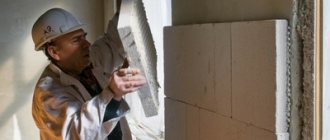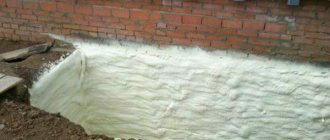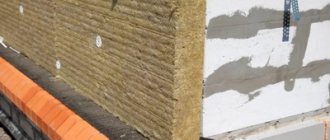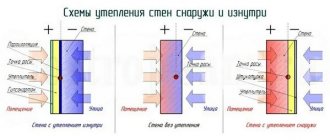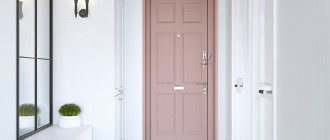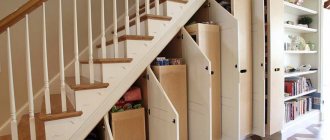To feel comfortable in an apartment or private house at any time of the year, you need to maintain an acceptable temperature regime.
Penoflex thermal insulation, carried out using modern materials, guarantees comfort in the house. When starting to build a house, it is very important to choose a highly efficient heat insulator, for example. [contents] Recently, a unique material has appeared for insulating walls, penoflex . This lightweight, durable material provides reliable protection for the structure of a multi-story, one-story house and any other buildings.
Penoflex is a new generation of insulation made from expanded polystyrene. Thanks to its technical characteristics, penoflex insulation has become the most common thermal insulation material throughout our country.
A little history
A brief history of the emergence of extruded polystyrene foam (the official name of penoplex) is as follows:
- 1941 _ Like many other useful things, the material was originally developed for the needs of the army (in this case, the US Navy). This year, The Dow Chemical company received a patent for a new development, and already in 1942 it established large-scale supplies. The moisture-resistant material with excellent heat-insulating properties was used in the production of boats and life rafts.
- 1952 _ After the war, the Americans continued to use penoplex, its use expanded significantly, first in the refrigeration industry, and then in construction.
- 1963 _ Extruded polystyrene foam has spread throughout Europe and has since occupied a stable niche in the insulation market.
- 1998 _ Extruded polystyrene foam began to be produced in Russia (in the Leningrad region) under the Penoplex trademark and was adequately appreciated by builders.
Extruded polystyrene foam made in Europe Source cleech.co
Roof thermal insulation
The work begins with laying insulation on the rafter system.
Measures to insulate this structural element are carried out either during construction or during the reconstruction of an old facility. Insulation is often carried out to turn a cold attic into a living space. Before starting work, you need to prepare the following materials:
- metal tiles or other roofing solution;
- sheathing;
- vapor-permeable moisture-resistant membrane;
- insulation;
- internal lining;
- rafter structure.
Work begins with laying insulation on the rafter system. The material is placed in a checkerboard pattern. After this, you need to lay a vapor-permeable membrane on it. Next, using longitudinal slats with a thickness of at least 40 cm, the heat insulator is fixed. In order to ensure ventilation between it and the roof, it is necessary to maintain a step of 300 mm.
After this, you can proceed to securing the transverse slats. Then, after placement, the roofing material is fixed on them. It is permissible to use metal tiles or any other.
Roll solutions for continuous flooring can be a good alternative
Penoplex differs from another popular insulation product - penoflex - by its high cost. However, this disadvantage is compensated by its excellent characteristics. It is ideal for use under plastering systems.
Penoplex is one of the best materials for creating effective thermal insulation. If you constantly feel cold in your home, then using it can solve this problem. There are significant costs involved in carrying out the work. But they are offset by savings on heating rooms. Proper implementation of the procedure minimizes heat loss and ensures comfortable living.
About production technology
Extruded polystyrene foam (penoplex, XPS) is a related material to ordinary polystyrene foam, commonly known as polystyrene foam. Penoplex is also made from polystyrene granules, but the technological chain has a different form:
- Preparing the mixture . The granules are loaded into a mixer, where they melt under the influence of elevated temperature, and after introducing a foaming agent under pressure, they form the desired homogeneous structure.
- Molding . The foam mixture passes through extruders (forming holes), is cooled and cut into slabs.
- Result . The structure of extruded polystyrene foam forms many small cells filled with air. Due to the fact that the cells are closed, the material acquires the properties of an excellent heat insulator. The color of the slabs is yellow-orange, less often blue.
Production (cutting) of slabs Source terman-s.ru
What is it made of? Compound
We have before us a completely artificial material, which is made from chemical components mixed in certain proportions. The technology involves using a temperature of 140 degrees, which causes the ingredients to melt and foam, forming porophores. If we talk about specifics, the following materials are used in production:
- Polystyrene.
- Ground perlite.
- Lemon acid.
- Tetrabromoparaxylene.
- Barium or zinc stearate.
- Bicarbonate of soda.
The use of such components in certain proportions forms a strong cellular-porous structure filled with gas.
Advantages and disadvantages of penoplex
Like any building material, penoplex has its strengths and weaknesses. Knowledge of the characteristics of the material will allow you to use it with maximum efficiency; Positive characteristics include the following parameters:
- Low thermal conductivity . The thermal conductivity coefficient does not exceed 0.03 W/m·ºK, which indicates a high degree of thermal insulation.
- Low water absorption . 0.5% by volume per month.
- High compressive and bending strength - 0.27 MPa. This property allows the slabs to be used not only as insulation, but also as a building material that is not subject to structural cracking.
- Light weight . Due to its low density, the material does not create a load on the supporting elements.
- Wide range of operation . The material does not lose properties in the range from -50 to +75°C.
- Durability . The service life is 30-50 years.
- Easy installation.
Thermal insulation properties of slabs in comparison with other materials Source tproekt.com
In order for penoplex to bring the expected benefits, you should also remember the disadvantages (and take them into account):
- Low vapor permeability . The indicator is worse than that of polystyrene foam, which makes you think about a good ventilation system.
- Flammability . Belongs to class G3-G4 (normally and highly flammable substances).
- Environmental friendliness . The material is safe for health if it does not contain harmful impurities. The existing variety is self-extinguishing polystyrene foam, impregnated with a fire retardant and can have a negative impact on humans.
- Extremely low sound insulation .
- UV instability . It is destroyed by exposure to sunlight and needs protection during storage.
- Instability to a number of organic solvents and other substances. These include gasoline, diesel fuel, oil paints, polyester resins, aromatic hydrocarbons, and ethers.
Work on insulating facades of complex shape Source hi.decorexpro.com
See also: Catalog of companies that specialize in insulating country houses.
Required thickness parameter
To insulate the outside of the house with penoplex with your own hands, you need to choose the appropriate thickness of the product. Here you should pay attention to the climate zone. When purchasing penoplex, insulation is carried out taking into account the fact that the insulating cake must provide a total heat transfer resistance of no less than that established in building codes and regulations.
For the calculation, the thermal conductivity coefficient of the insulation is additionally required. To find out the thickness of penoplex , you can use the following formula: P (thickness, m) = R (heat transfer resistance, which can be taken from official SNiP sources) * k (thermal conductivity index).
Types and sizes of thermal insulation boards
Manufacturers produce foam sheets, the size and specific density of which are indicated on the packaging and determine the limits of use of the material. The following types of slabs are available:
- For walls . Plates with a density of 25-32 kg/m3 are used to insulate the facade (due to the low vapor permeability of the material, additional vapor barrier of the interior will be required). When externally insulating a non-residential building, a vapor barrier is not required. Finally, you can plaster over a metal mesh, or cladding with a façade material of your choice (lining, siding, ceramic tiles).
- For roofing . It is known that up to 20% of heat is lost through a poorly insulated roof. Penoplex "Roof" is designed specifically for thermal insulation of roofs, pitched or flat. Lightweight and moisture-resistant slabs with a density of 28-33 kg/m3 are simply joined together without the formation of cold bridges. The material is rigid enough to withstand significant installation and operating loads; it is equipped with a groove that ensures a tight fit.
Packaging labeling Source samodelino.ru
- For the foundation . The increased density of the slabs (29-33 kg/m3) allows them to be used for arranging the foundation, ground floor, garden paths, insulating septic tanks and utilities.
- Penoplex "Comfort" . Sheets with a density of 25-35 kg/m3 have an L-shaped edge, so they can be installed without any problems. Thermal insulation boards are widely used in private housing construction (including insulation of baths, saunas and swimming pools), as well as for high-quality insulation of apartments (especially loggias and balconies).
- Penoplex 45 (GEO) . High-density (35-47 kg/m3) material, suitable for use under constant heavy loads. It is used for insulation of runways, roads (roads and railways), exploited roofs, parking lots and pedestrian areas.
There are calculation tables for various regions that determine the choice of foam sheets; the thickness in them is a key indicator. The most commonly used plates are 20-100 mm thick. Depending on the brand, the length varies between 1200-2400 mm, the width is always the same - 600 mm. The number of slabs in a package can vary from 4 to 18 pieces.
Required materials
To insulate the outside of a house with penoplex, you need to select the necessary consumables. In this case, the work will go smoothly. For insulation you need:
- Penoplex boards. Their number is calculated depending on the area of the base, as well as adding a 10% margin for cutting.
- Primer liquid. It improves the adhesion of sheets to the base. The type of substance depends on the material used to make the walls: for brick surfaces , plastered surfaces made of gas silicate blocks, a deep penetration primer (300 ml/sq.m.) is suitable, and for concrete surfaces, Concrete Contact containing quartz sand (400 ml/sq.m.).
- To insulate external walls with penoplex, a starting profile is required. It is needed for proper fastening of the first row of slabs. The element is installed around the perimeter of the entire building. Included with it are spacer washers that allow you to correct minor unevenness in the base. The number of profiles is calculated depending on the length of the walls, and fasteners - 1-2 per joint. To fasten the supporting elements, dowels are used, the distance between which is 30 cm.
- To insulate walls with extruded polystyrene foam, you need special glue. The average material consumption at the first stage is 5 kg/sq.m. An additional layer will be required to secure the layer of reinforcing mesh. In general, it will take up to 10 kg/sq.m. material.
- Dowels are “fungi”. They can be hammered or screwed. It is better to choose products with a thermal head or a plastic expansion nail. For each square meter of area you will need 6 elements.
- Reinforcing mesh. It is better to purchase fiberglass-based material. For finishing you will need up to 1.1 sq.m/sq.m.
For the decorative plaster layer, materials with different textures are used, so the consumption is calculated after external insulation.
Methods for attaching penoplex
In modern suburban construction, the installation of penoplex slabs is carried out in three ways:
- Using an adhesive composition . A universal method suitable for insulating a large surface, facade or basement, followed by plastering.
- Using fasteners . If a significant load on the insulation layer is not expected, the sheets are secured using plastic disc dowels. The method is suitable for insulating a basement or loggia.
- Using polyurethane foam . The advantage of polyurethane foam is its high adhesion (adhesion to the surface) plays an important role in insulating floors, attic floors and walls.
Methods for installing slabs Source vest-beton.ru
general information
Penoplex is a material consisting of foamed polystyrene, which is produced by extrusion. It can be used to solve a wide range of problems in the field of thermal insulation of objects. It is actively used not only during work in residential premises. This often happens when it is used to insulate industrial structures.
Thermal insulation of attic rooms and building facades is carried out more and more often using this product
This product was developed in the USA. A special technique, which involved the use of the extrusion method, made it possible to obtain a new solution with a uniform structure. The insulation contains many small cells with a finishing coating. Their size does not exceed 0.2 mm.
The heat insulator production technology involves mixing polystyrene in granules under conditions of high temperature and pressure.
During this operation, a foaming agent is added. Oxygen dioxide is used as such, or a mixture consisting of two light types of freons is used. At the final stage of production, the remaining foaming agent in the cells is easily filled with ambient air. Read also: detailed characteristics and properties of polystyrene foam.
In this video we will show you which insulation should be used for your home:
Insulation of the facade: stages of installing slabs with glue
The process of insulating a façade with penoplex slabs is as follows:
- Surface preparation . Contaminants and the old cladding layer are removed from the working base. If there are mold spots, they are treated separately (disinfected with copper sulfate). If necessary, the surface is leveled and primed.
- Installation . The sheets are glued in rows, from bottom to top, with bandaging (offset) of the seams. The adhesive composition is applied to the foam sheet in two crosswise lines. In an alternative method, if the glue is applied to the work surface, it is done in a continuous layer. Each slab is pressed against the wall, its position is checked by level.
How not to lose money
If designers and builders do not take into account the physical and chemical characteristics of penoplex, its strength and thermal characteristics deteriorate long before the end of its service life, which leads to a decrease in the thermal efficiency of the house. Some of the most common errors include the following solutions:
- Use of material with a density lower than technologically justified . Penoplex, like any polymer, is oxidized by atmospheric oxygen. The rate of oxidation (change in chemical structure and deterioration in performance properties) depends on the density of the material. The use of slabs with a lower density (an understandable desire to save money) deteriorates the thermal protection of the structure 2-3 times faster, and this is noticeable already in the first 7-10 years of operation.
Internal insulation Source chebaki.ru
- Use of incompatible materials . Plates made of extruded polystyrene foam will deteriorate at an accelerated rate if substances that are dangerous to the structure of the penoplex (for example, oil-based paints containing volatile hydrocarbons) are used during construction.
- Ignorance of labeling features . An inexperienced person, seeing the words “Mark 25” on the packaging, makes the logical conclusion, in his opinion, that inside there are slabs with a density of 25 kg/m3. But in technical specifications this is the designation for material with a density from 15.1 to 25.0 kg/m3. Some manufacturers, caring for maximum profits, supply penoplex of the lowest density under this brand (15.1 kg/m 3 , the density of packaging plastic). The result of the substitution soon appears on the “insulated” façade – with damp spots and mold.
- Incorrectly carried out insulation . Improper insulation leaves an air gap between the wall and the slab material. The structure becomes inhomogeneous, the dew point shifts into the gap. Condensation is inevitably absorbed into a denser material (wall), and thermal efficiency drops, sometimes significantly.
The insulation is complete, the finishing cladding is ahead Source doma-otido.ru
Available analogues. What is the difference? Which is better and warmer?
- Penoplex or Mineral wool
- Penoplex or Foam plastic
- Technoplex or Penoplex
- Styrex or Penoplex
- Izolon or Penoplex
If you compare these materials, you must take into account their scope of application. For example, mineral wool is definitely not suitable for a foundation or basement: it absorbs moisture well, which leads to weight gain. Accordingly, the insulation slides down, exposing the walls. To avoid these problems, you will have to install additional moisture insulation, and this proportionally increases costs.
However, in terms of heat and sound insulation, Penoplex loses to mineral wool, although the latter material looks more difficult in terms of installation.
Both materials do not absorb moisture, so they are equally suitable for insulating basements. Thermal conductivity indicators are better for Penoplex, but only slightly. It is worth noting that polystyrene foam can be classified as an eternal material, and the service life of Penoplex declared by the manufacturer is 50 years .
Therefore, for internal and external insulation, both materials can be used with equal efficiency, but if service life plays a decisive role, it is better to give preference to polystyrene foam.
These are two materials that are almost identical in their properties. Here you can observe the same indicators of mechanical strength and bending resistance: 250 kPa and 0.4 MPa , respectively.
If we talk about resistance to sub-zero temperatures, then Technoplex looks warmer - the operating temperature of the material: -70 degrees Celsius , however, such temperatures are difficult to meet in most regions of Russia. The thermal conductivity of the insulation is the same: 0.031 W/mK , but Technoplex is more resistant to humid environments.
There are no fundamental differences between these materials, so they have an identical scope of application. Here we can highlight the following difference: Stirex is more resistant to bending deformation, but is more expensive to purchase. In addition, Stirex is more suitable for insulating rooms where there is a significant difference between external and internal temperatures.
Thanks to its structure, Izolon is ideal for insulating floors and roofs, increasing the thermal and sound insulation of rooms. However, for walls it is better to use Penoplex as a material that is more convenient to install.
